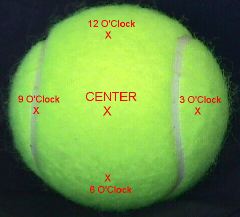A challenge we noobs face is consistency. I diligently head to the courts about three times a week just to hit serves alone. This does not include hitting with friends, team practice, weekly club events such as our Thursday night Fight Club, or formal match play. Just a basket of balls and about 50+ serves (sometimes about 100 but I've read that'snot good for over 40 shoulders.)
I can now hit a respectable kick serve in that it curves, dives, stays in, but has only ok pace. A level players would use it for target practice. Fellow B level players can return it but need to think about it. Recently I tried a full eastern back hand for kick serves and LOVE the results! In practice I can bomb serves into the corner near the net...sometimes!
My flat serve stinks. Getting better, but low enough percentage that I tend to avoid it in matches. I only pull it out enough to keep opponents honest. I'll even risk a point and use it as a second serve just so they don't assume the seond will be a kick serve.
Here'smy problem. I'd like to use my flat serve more to develop it under match conditions but I find switching between flat and kick rather difficult. I'm simply not good enough to hit a flat first serve followed by a second kick serve. Not enough muscle memory yet I suppose.
As I workon serves is there an all purpose serve technique between hard flat serve and monster bomb kick serves? Something like an extra spinny flat serve or flatter top spin serve that, using a single motion, is highly likely to go in with one or two attempts? If yes, is that accomplished primarily with grip or swing path? Or is this not adisable and one shoild simply stick with distinct flat and spin serves, especially as a noob?
In other words, is there a respectable all purpose B level serve that's reliable enough and fast enough to be used for both first and second serves? Any advice would be much appreciated. Last week I hurt my elbow and arm so I've barely been able to serve anyway (trying to serve during a match on Saturday was murder!). Later This week I intend to return to practiceand hope to give something like this a try.
I can now hit a respectable kick serve in that it curves, dives, stays in, but has only ok pace. A level players would use it for target practice. Fellow B level players can return it but need to think about it. Recently I tried a full eastern back hand for kick serves and LOVE the results! In practice I can bomb serves into the corner near the net...sometimes!
My flat serve stinks. Getting better, but low enough percentage that I tend to avoid it in matches. I only pull it out enough to keep opponents honest. I'll even risk a point and use it as a second serve just so they don't assume the seond will be a kick serve.
Here'smy problem. I'd like to use my flat serve more to develop it under match conditions but I find switching between flat and kick rather difficult. I'm simply not good enough to hit a flat first serve followed by a second kick serve. Not enough muscle memory yet I suppose.
As I workon serves is there an all purpose serve technique between hard flat serve and monster bomb kick serves? Something like an extra spinny flat serve or flatter top spin serve that, using a single motion, is highly likely to go in with one or two attempts? If yes, is that accomplished primarily with grip or swing path? Or is this not adisable and one shoild simply stick with distinct flat and spin serves, especially as a noob?
In other words, is there a respectable all purpose B level serve that's reliable enough and fast enough to be used for both first and second serves? Any advice would be much appreciated. Last week I hurt my elbow and arm so I've barely been able to serve anyway (trying to serve during a match on Saturday was murder!). Later This week I intend to return to practiceand hope to give something like this a try.
Last edited:

